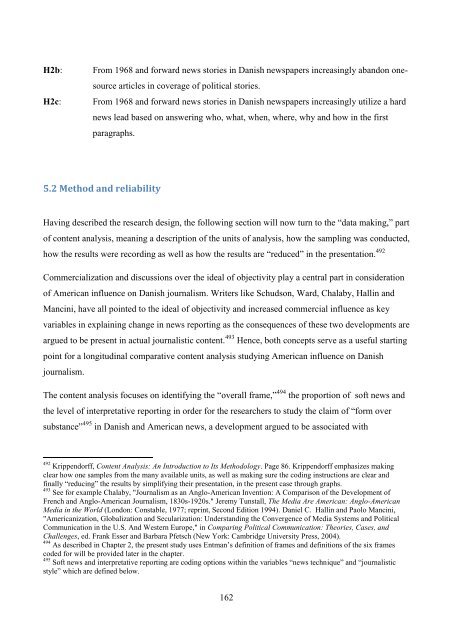The Jeremiad Over Journalism
The Jeremiad Over Journalism
The Jeremiad Over Journalism
Create successful ePaper yourself
Turn your PDF publications into a flip-book with our unique Google optimized e-Paper software.
H2b: From 1968 and forward news stories in Danish newspapers increasingly abandon one-<br />
source articles in coverage of political stories.<br />
H2c: From 1968 and forward news stories in Danish newspapers increasingly utilize a hard<br />
news lead based on answering who, what, when, where, why and how in the first<br />
paragraphs.<br />
5.2 Method and reliability<br />
Having described the research design, the following section will now turn to the ―data making,‖ part<br />
of content analysis, meaning a description of the units of analysis, how the sampling was conducted,<br />
how the results were recording as well as how the results are ―reduced‖ in the presentation. 492<br />
Commercialization and discussions over the ideal of objectivity play a central part in consideration<br />
of American influence on Danish journalism. Writers like Schudson, Ward, Chalaby, Hallin and<br />
Mancini, have all pointed to the ideal of objectivity and increased commercial influence as key<br />
variables in explaining change in news reporting as the consequences of these two developments are<br />
argued to be present in actual journalistic content. 493 Hence, both concepts serve as a useful starting<br />
point for a longitudinal comparative content analysis studying American influence on Danish<br />
journalism.<br />
<strong>The</strong> content analysis focuses on identifying the ―overall frame,‖ 494 the proportion of soft news and<br />
the level of interpretative reporting in order for the researchers to study the claim of ―form over<br />
substance‖ 495 in Danish and American news, a development argued to be associated with<br />
492<br />
Krippendorff, Content Analysis: An Introduction to Its Methodology. Page 86. Krippendorff emphasizes making<br />
clear how one samples from the many available units, as well as making sure the coding instructions are clear and<br />
finally ―reducing‖ the results by simplifying their presentation, in the present case through graphs.<br />
493<br />
See for example Chalaby, "<strong>Journalism</strong> as an Anglo-American Invention: A Comparison of the Development of<br />
French and Anglo-American <strong>Journalism</strong>, 1830s-1920s." Jeremy Tunstall, <strong>The</strong> Media Are American: Anglo-American<br />
Media in the World (London: Constable, 1977; reprint, Second Edition 1994). Daniel C. Hallin and Paolo Mancini,<br />
"Americanization, Globalization and Secularization: Understanding the Convergence of Media Systems and Political<br />
Communication in the U.S. And Western Europe," in Comparing Political Communication: <strong>The</strong>ories, Cases, and<br />
Challenges, ed. Frank Esser and Barbara Pfetsch (New York: Cambridge University Press, 2004).<br />
494<br />
As described in Chapter 2, the present study uses Entman‘s definition of frames and definitions of the six frames<br />
coded for will be provided later in the chapter.<br />
495<br />
Soft news and interpretative reporting are coding options within the variables ―news technique‖ and ―journalistic<br />
style‖ which are defined below.<br />
162
















